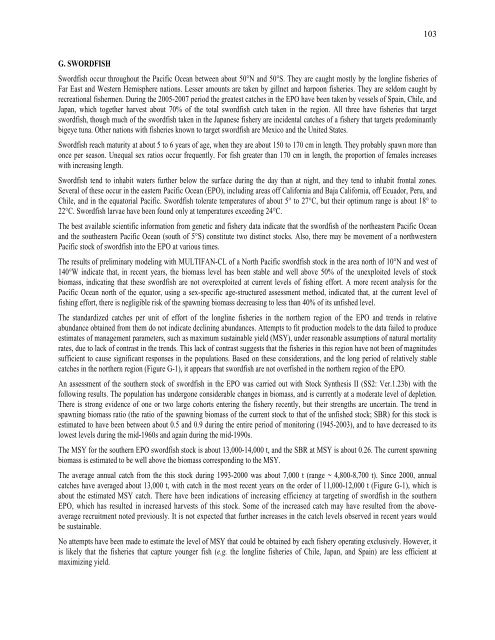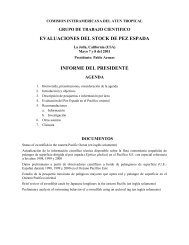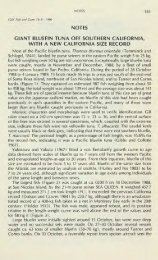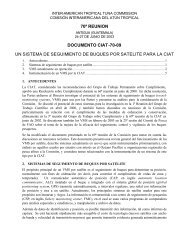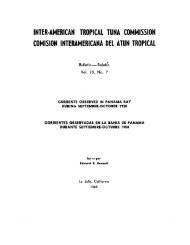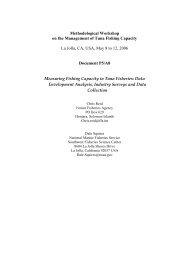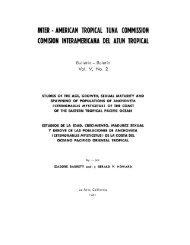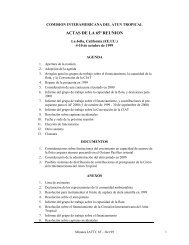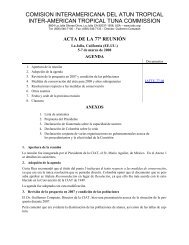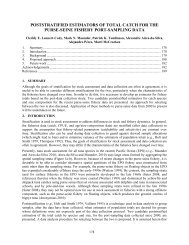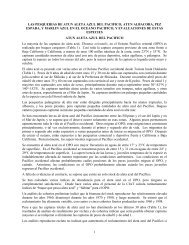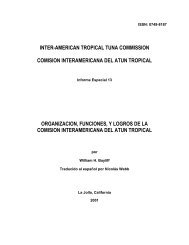INTER-AMERICAN TROPICAL TUNA COMMISSION - Comisión ...
INTER-AMERICAN TROPICAL TUNA COMMISSION - Comisión ...
INTER-AMERICAN TROPICAL TUNA COMMISSION - Comisión ...
- No tags were found...
You also want an ePaper? Increase the reach of your titles
YUMPU automatically turns print PDFs into web optimized ePapers that Google loves.
103G. SWORDFISHSwordfish occur throughout the Pacific Ocean between about 50°N and 50°S. They are caught mostly by the longline fisheries ofFar East and Western Hemisphere nations. Lesser amounts are taken by gillnet and harpoon fisheries. They are seldom caught byrecreational fishermen. During the 2005-2007 period the greatest catches in the EPO have been taken by vessels of Spain, Chile, andJapan, which together harvest about 70% of the total swordfish catch taken in the region. All three have fisheries that targetswordfish, though much of the swordfish taken in the Japanese fishery are incidental catches of a fishery that targets predominantlybigeye tuna. Other nations with fisheries known to target swordfish are Mexico and the United States.Swordfish reach maturity at about 5 to 6 years of age, when they are about 150 to 170 cm in length. They probably spawn more thanonce per season. Unequal sex ratios occur frequently. For fish greater than 170 cm in length, the proportion of females increaseswith increasing length.Swordfish tend to inhabit waters further below the surface during the day than at night, and they tend to inhabit frontal zones.Several of these occur in the eastern Pacific Ocean (EPO), including areas off California and Baja California, off Ecuador, Peru, andChile, and in the equatorial Pacific. Swordfish tolerate temperatures of about 5° to 27°C, but their optimum range is about 18° to22°C. Swordfish larvae have been found only at temperatures exceeding 24°C.The best available scientific information from genetic and fishery data indicate that the swordfish of the northeastern Pacific Oceanand the southeastern Pacific Ocean (south of 5°S) constitute two distinct stocks. Also, there may be movement of a northwesternPacific stock of swordfish into the EPO at various times.The results of preliminary modeling with MULTIFAN-CL of a North Pacific swordfish stock in the area north of 10°N and west of140°W indicate that, in recent years, the biomass level has been stable and well above 50% of the unexploited levels of stockbiomass, indicating that these swordfish are not overexploited at current levels of fishing effort. A more recent analysis for thePacific Ocean north of the equator, using a sex-specific age-structured assessment method, indicated that, at the current level offishing effort, there is negligible risk of the spawning biomass decreasing to less than 40% of its unfished level.The standardized catches per unit of effort of the longline fisheries in the northern region of the EPO and trends in relativeabundance obtained from them do not indicate declining abundances. Attempts to fit production models to the data failed to produceestimates of management parameters, such as maximum sustainable yield (MSY), under reasonable assumptions of natural mortalityrates, due to lack of contrast in the trends. This lack of contrast suggests that the fisheries in this region have not been of magnitudessufficient to cause significant responses in the populations. Based on these considerations, and the long period of relatively stablecatches in the northern region (Figure G-1), it appears that swordfish are not overfished in the northern region of the EPO.An assessment of the southern stock of swordfish in the EPO was carried out with Stock Synthesis II (SS2: Ver.1.23b) with thefollowing results. The population has undergone considerable changes in biomass, and is currently at a moderate level of depletion.There is strong evidence of one or two large cohorts entering the fishery recently, but their strengths are uncertain. The trend inspawning biomass ratio (the ratio of the spawning biomass of the current stock to that of the unfished stock; SBR) for this stock isestimated to have been between about 0.5 and 0.9 during the entire period of monitoring (1945-2003), and to have decreased to itslowest levels during the mid-1960s and again during the mid-1990s.The MSY for the southern EPO swordfish stock is about 13,000-14,000 t, and the SBR at MSY is about 0.26. The current spawningbiomass is estimated to be well above the biomass corresponding to the MSY.The average annual catch from the this stock during 1993-2000 was about 7,000 t (range ~ 4,800-8,700 t). Since 2000, annualcatches have averaged about 13,000 t, with catch in the most recent years on the order of 11,000-12,000 t (Figure G-1), which isabout the estimated MSY catch. There have been indications of increasing efficiency at targeting of swordfish in the southernEPO, which has resulted in increased harvests of this stock. Some of the increased catch may have resulted from the aboveaveragerecruitment noted previously. It is not expected that further increases in the catch levels observed in recent years wouldbe sustainable.No attempts have been made to estimate the level of MSY that could be obtained by each fishery operating exclusively. However, itis likely that the fisheries that capture younger fish (e.g. the longline fisheries of Chile, Japan, and Spain) are less efficient atmaximizing yield.


